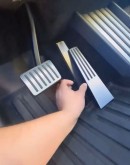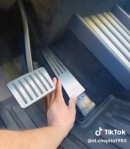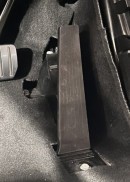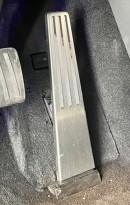Earlier this week, Tesla stopped Cybertruck deliveries after owners complained about a faulty accelerator pedal that could lead to a crash. After analyzing the issue, Tesla issued a recall for 3,878 Cybertrucks to replace the faulty pedals. The EV maker says it's unaware of any collisions, injuries, or deaths related to this condition.
Tesla owners have always mocked the NHTSA for using the word "recall," even when the issue can be solved with a software update. Even worse, the agency insists on sending physical letters to the owners of vehicles affected by a recall. This happens even though a software update has already solved the issue by the time the letter is posted. However, from time to time, even Tesla EVs need to visit a service center to fix safety-related problems.
Earlier this week, we learned that Tesla stopped Cybertruck deliveries after several owners complained about a faulty accelerator pedal. Specifically, the Cybertruck has metal covers for the accelerator pedals, which can shift out of position when the foot applies forward pressure on the accelerator. The problem is made worse by the fact that the Cybertruck features a floor-mounted accelerator pedal instead of a hanging pedal like other Tesla EVs.
To make matters worse, Tesla doesn't use any fastener to secure the pedal cover in place. Instead, it relies on adhesive to do the job. Unfortunately, it appears that workers on the production line used soap to aid the cover assembly onto the accelerator pedal. The soap reduced the retention of the pad to the pedal, and foot pressure on it could cause it to shift out of position. When this happens, the pedal cover can get trapped in the interior trim above the pedal. This prevents it from reverting to its idle position, which can lead to a crash.
Tesla says it doesn't know of any accident caused by the pedal failure, although some Cybertruck owners have complained on social media that it caused them to crash. However, due to the safety measures Tesla implemented, pressing the brake pedal will cut the drive torque, including when both brake and accelerator pedals are pressed. Pressing the brake pedal while the accelerator is jammed to the floor will stop the vehicle just as quickly as if the accelerator was not pressed. If this is the case, an audible and visual alert warns the driver that both brake and accelerator pedals are being pressed.
According to the documents filed with the NHTSA, the defect affected 3,878 Cybertrucks. This should be the entire Cybertruck fleet that has been produced until now, which suggests that production ramp-up is still in the early stages. Tesla has already replaced the faulty pedals on vehicles on the production line and those waiting for delivery. This allowed it to resume deliveries on April 17. Owners of Cybertrucks that have already been delivered will soon receive a letter to have their pedals replaced at a Tesla service center.
Earlier this week, we learned that Tesla stopped Cybertruck deliveries after several owners complained about a faulty accelerator pedal. Specifically, the Cybertruck has metal covers for the accelerator pedals, which can shift out of position when the foot applies forward pressure on the accelerator. The problem is made worse by the fact that the Cybertruck features a floor-mounted accelerator pedal instead of a hanging pedal like other Tesla EVs.
To make matters worse, Tesla doesn't use any fastener to secure the pedal cover in place. Instead, it relies on adhesive to do the job. Unfortunately, it appears that workers on the production line used soap to aid the cover assembly onto the accelerator pedal. The soap reduced the retention of the pad to the pedal, and foot pressure on it could cause it to shift out of position. When this happens, the pedal cover can get trapped in the interior trim above the pedal. This prevents it from reverting to its idle position, which can lead to a crash.
Tesla says it doesn't know of any accident caused by the pedal failure, although some Cybertruck owners have complained on social media that it caused them to crash. However, due to the safety measures Tesla implemented, pressing the brake pedal will cut the drive torque, including when both brake and accelerator pedals are pressed. Pressing the brake pedal while the accelerator is jammed to the floor will stop the vehicle just as quickly as if the accelerator was not pressed. If this is the case, an audible and visual alert warns the driver that both brake and accelerator pedals are being pressed.
According to the documents filed with the NHTSA, the defect affected 3,878 Cybertrucks. This should be the entire Cybertruck fleet that has been produced until now, which suggests that production ramp-up is still in the early stages. Tesla has already replaced the faulty pedals on vehicles on the production line and those waiting for delivery. This allowed it to resume deliveries on April 17. Owners of Cybertrucks that have already been delivered will soon receive a letter to have their pedals replaced at a Tesla service center.
There were no injuries or accidents because of this. We are just being very cautious.
— Elon Musk (@elonmusk) April 18, 2024






